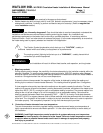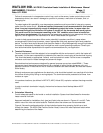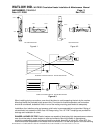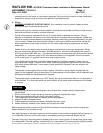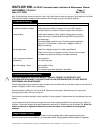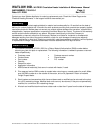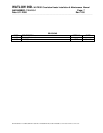
WATLOW IND. WATROD
Circulation Heater Installation & Maintenance Manual
I&M NUMBER: 316-42-5-1 Page: 4
Date: 6/11/2008 Rev: 2.00
________________________________________________________________________________________________________________________________________________________________________________________________________________________
WATLOW IND.n # 6 INDUSTRIAL LOOP RD. n HANNIBAL MO, 63401n PHONE 573-221-2816 n FAX 573-221-3723
atmosphere when the heater is continuously energized. Care should also be taken to keep combustible
materials far enough away to be free of the effects of high temperatures.
5. Wiring
WARNING;
HAZARD OF ELECTRIC SHOCK. Any installation involving electric heaters must be
grounded to earth to eliminate shock hazard.
Electrical wiring to the heaters must be installed in accordance with the National Electric Code and any
state and local electrical code by qualified personnel.
Consult wiring diagram supplied with the unit for correct feeder or leadwire connections. If wiring
diagram is not supplied, the factory should be consulted for the appropriate wiring diagram. Feeder wire
should be properly selected based on amperage, electrical power rating, ambient temperature, and type
of environment. Feeder wire should also be housed in either rigid or flexible conduit which carries the
same classification as the heater enclosure. It is the users responsibility to properly size and install
feeder wire.
Feeder wire line connections may be made directly to stud terminals or box type compression fittings.
Box type compression fittings will accept a #4 AWG maximum wire while stud terminals will accept a
#10 ring connector(T&B, Amp, etc.). It is essential that these connections be tight. Stud terminals should
be tightened to a maximum torque of 20 in-lbs while the bottom nut is supported. Ground connection
(color coded "green") is supplied inside the housing for ground wire.
Line voltage must be equal to or less than rating stamped on the heater assembly. Some units are
supplied as dual voltage . Example: 240V / 480V, check wiring diagram supplied with the unit to make
sure which scheme was used. In most cases (unless specified by customer) units are wired for the
higher voltage.
Thermostats can be supplied with circulation heaters. Consult the wiring diagram supplied with the
heater for the suggested wiring of thermostats. For safe operation of thermostats, consult Installation and
Maintenance manual for thermostats that is attached.
Thermostats should not be used as an "OFF" device; the use of a disconnect switch or circuit breaker is
recommended. The disconnect switch will allow isolation of the heater when maintenance of the heater
is required.
Start Up
Before energizing the heater the following items should have been checked with the heater power
disconnected:
1. Electrical termination is tight and wiring is per wiring diagram supplied with heater
2. Proper disconnecting means and fusing have been installed
3. The voltage rating of the heater is the same as that being applied
4. Megohm is within acceptable limits
5. Proper temperature controls and safety limiting devices are in place
6. Heater is securely installed in tank header and no leaks are visible
Before energizing heater, correct fluid flow should be maintained over the heater bundle to ensure that
heater elements do not overheat and fail.
After applying power to the heater make sure that the system is being controlled properly before leaving it to
run unattended. Failure to do this could result in overheating resulting in personnel danger and fire.
Thermal cycling may cause the gasket or sealed joints to relax causing a leak. On flange units, tighten bolts
to re-seat gasket. If the leak persists, contact factory for a new gasket. On screw plug units, tighten threaded



